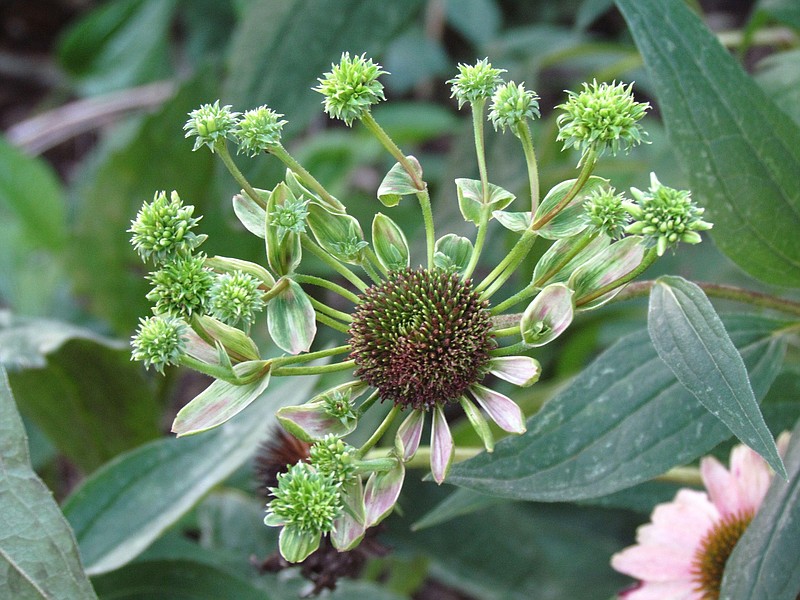Q I am attaching two photographs of a coneflower plant in my garden. The plant has been coming back each spring and blooming for the last three years. It's supposed to be the purple variety. This year I noticed, for the first time, this strange growth around the cone. Is it a disease or some sort of mutation that has caused this?
A It is a disease called Aster Yellows. This viral-like disease is spread by tiny insects called leafhoppers. There is no cure, so you will need to destroy the plant.

Q Every year these bugs cover my spent butterfly weed plants. Are they friends? Do I need to leave them alone? They don't seem to bother anyone else in the flower beds.
A They are milkweed bugs. While not very destructive, when
they come, they come in large numbers -- no social distancing for them! They do feed on the milkweed seed pods, so if you want seeds, try to knock off the insects into a bucket filled with water and a little vegetable oil. Insecticides would harm the monarch caterpillars and butterflies too, and so are not recommended. Some gardeners live with the milkweed bugs, while others think a large presence of these deters the monarchs.

Q Why are my Limelight hydrangeas always flopping over? Maybe they aren't getting enough sun and would like to be moved? (They are in a semi-sunny area.) Maybe I should support each branch? Or trim at a different time? Or not at all? Several are lying on the ground.
A I have found that severe pruning of panicle types of hydrangeas encourages rapid new growth, which can't support the weight of the blooms, and the branches bend under the weight. I have several in my garden, and I find when I limit how much, if any, I prune, the branches are much woodier and can hold the blooms upright.
Q I have a crape myrtle question. About 40 years ago my wife moved a volunteer purple crape myrtle from a cemetery in Dardanelle. It's still in our yard in Little Rock, though with changes. It flourished until about 12 years ago. Then, over several years after a tornado came through, new trees were planted nearby and the crape myrtle didn't bloom as much because of the shade. Now one branch has the purple flowers, but the others with blooms are white. There is a white crape myrtle about 6 feet away. Unfortunately, the plant in the Dardanelle cemetery is gone. Is it normal for crape myrtle flowers to change colors over time?
A Typically the plants don't change color, but you could have a sport of another variety or a seedling or root sucker of another plant growing together. If you want the purple, cut out all of the white variety. We often will have a variegated plant that will begin to outgrow the variegated pattern, and the solid color tends to be more vigorous. The same thing can happen with colored blooms. Sometimes one variety will be more vigorous than the other and take over.

Q I have several beds of four o'clocks in different parts of my yard, each getting variation of amounts of sun/shade. I harvest seeds from them each year to plant in other areas in the spring. My question is ... if I harvest seeds from yellow four o'clock, for example, will I get yellow four o'clock next spring? I have heard that a seed from a pink bloom doesn't necessarily mean you will get a pink flower the next time and so on with all the colors.
A Unfortunately, four o'clocks don't breed true from seed. You will get a mix of colors.
Retired after 38 years with the University of Arkansas Cooperative Extension Service, Janet Carson ranks among Arkansas' best known horticulture experts. Her blog is at arkansasonline.com/planitjanet. Write to her at P.O. Box 2221, Little Rock, AR 72203 or email
jcarson@arkansasonline.com
